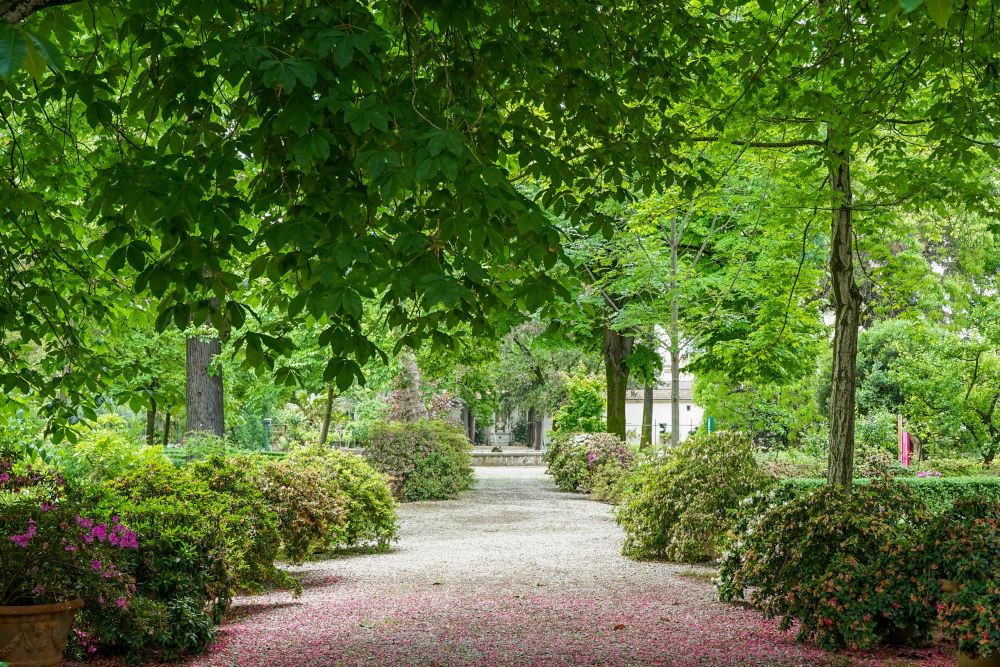5 Gardens to visit in spring with Firenzecard
Tue, 07/15/2025 - 09:45
Spring in Florence is synonymous with parks and gardens in bloom, palettes of a thousand colors, with inebriating scents, where camellias, tulips, wisteria, peonies, roses, etc. awaken and bloom. Italian gardens, English gardens, gardens embellished with fountains or sculptures.
Today we propose 4 gardens where you can admire spring in all its beauty:
1. Villa Bardini Garden. Here, three varieties of wisteria give us in April the magic of a path with shades of lilac, violet, purple, and pink, overlooking one of the most beautiful views of Florence. The Bardini Garden embodies seven centuries of both Florentine and gardening history, of innovation and change in botany and in fashions, and it combines three areas that differ in era and style: the Italian garden, with its magnificent Baroque staircase; the English wood, a rare example of an Anglo-Chinese garden with its exotic plants; the agricultural park with its new fruit orchard and its magnificent wisteria pergola. The Garden currently houses some two hundred pieces of sculpture, thirteen fountains, three grottoes, a superb “fountain wall” and a botanical collection chiefly made up of centuries-old trees such as holm oaks and phyllireas, olive trees, a vast number of hortensias, roses, camelias, azaleas and, of course, the splendid wisteria pergola.
2. Boboli Gardens. Here, spring is a fascinating combination of art and nature. It is no coincidence that Boboli is one of the oldest and most important examples of an Italian garden in the world, so much so that it inspired the gardens of the Palace of Versailles. 45,000 acres of green space with fountains, sculptures, and caves. Here among other flowers we can admire a collection of Antique and Modern Roses with 156 varieties. The Medici were the first to take care of its arrangement, creating the model of an Italian garden that became an example for many European courts. The vast green area, divided in a regular way, constitutes a true open-air museum, populated by ancient and Renaissance statues, adorned with grottos, first of all the very famous one created by Bernardo Buontalenti, and large fountains, such as that of Neptune and the Ocean.
3. “Giardino dei Semplici” Botanical Garden. Spring is the best season to visit the Giardino dei Semplici, the third oldest Botanical Garden in the world. A true riot of colors and scents, with its heritage of 9,000 plant specimens. In this living open-air museum, each season is able to reserve elements of interest and curiosity for the visitor, from the neophyte to the expert. The botanical year in fact begins in February with the early flowering of bulbous plants and then continues with the explosion of colors and shapes of the spring-flowering collections such as azaleas, roses and spontaneous orchids. Summer, on the other hand, is the season of hydrangeas and tropical aquatic plants (water lilies, blue lotus of the Nile, lotus flowers, etc.) that thrive in the outdoor pools, but also the season in which to admire the domestic vegetable garden and the medicinal species in their maximum luxuriance. The warm colors of the foliage of the over 150 tree species present, including broadleaf and evergreen species, make autumn one of the most fascinating seasons in the Garden.
4. Garden of the Medici Villa of the Petraia. The garden is developed on three terraced levels, taking advantage of the slope of the site: the level of the parterres, the level of the nursery and the level of the figurine, still maintaining intact the geometric spatiality of the original sixteenth-century garden, which is due to Ferdinando I de’ Medici, depicted in the lunette by Giusto Utens preserved, together with the other thirteen of the series, in the villa. The Figurina level takes its name from the bronze sculpture of the Venus Fiorenza, a masterpiece by Giambologna, placed at the crown of the Labyrinth fountain, transferred here from the Garden of the Villa di Castello in 1788, at the time of Pietro Leopoldo di Lorena, and today preserved in a room inside the villa. In the Park it is possible to admire, among other flowers, spontaneous orchids.
5. Garden of the Medici Villa of Castello. This garden can be considered the prototype of the sixteenth-century Italian garden. It was created as a significant part of an overall program of renovation and decoration of the Villa. The project was entrusted to Niccolò Pericoli, known as Tribolo, who was also responsible for the construction of the impressive hydraulic system, which would have fed the numerous fountains. Highlights of the rich and complex decorative project developed by Tribolo, together with Pierino da Vinci and other artists, are: the fountain of Hercules and Antaeus and the extraordinary Grotto of the Animals or of the Flood. Among the most famous in Europe, the grotto, designed by Tribolo himself, was originally animated by spectacular water games, simulating a natural cave in which sculptural groups of animals in polychrome marble are assembled. The garden boasts an exceptional collection of citrus fruits, consisting of around five hundred plants of historical and botanical importance unique in the world, descending from the ancient Medici varieties with specimens over three hundred years old. The plants are rigorously cared for according to ancient cultivation techniques, exposed outdoors from April to October and sheltered in the historic lemon groves during the winter. The garden of medicinal herbs is also a true jewel with the Stufa dei mugherini, which houses the rare Indian jasmine of Goa called “mugherino”, which gives its name to the greenhouse of the so-called “ortaccio” or Secret Garden.
